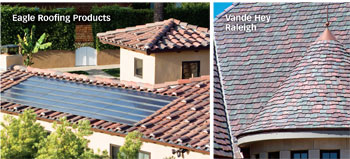Natural Insulators Along with their recyclability, clay and concrete tiles boast another green benefit: The air space that runs between the bottom of the tile and the top of the roof creates a thermal barrier in tile roofing systems. That thermal barrier keeps homes cooler in the summer and warmer in the winter, the Tile Roofing Institute says. The Department of Energy found that, compared to asphalt shingles, this can cut heat transfer by up to 70%.
Consequently, many tile products can be certified as cool roof products by Energy Star. Certified cool or reflective roofing results, on average, in a 7% to 15% energy savings in total cooling costs, according to the Cool Roof Rating Council (CRRC).
“Clay is a naturally reflective product,” Thomas says. “Virtually all of our products–just a small percentage aren’t–are CRRC-rated.” Thus, US Tile offers products in rich, deep colors that still qualify as cool roof materials.
Such factors would speak well for tiles’ near-term prospects were it not for the recession. Gardener says he has found people generally try to spend their housing money in a progressive manner. “But then dollars come into play, and they only actually [choose the more expensive tile option] if it makes personal economic sense,” he says.
Nevertheless, manufacturers have noticed a growing interest in roofing tile in northern states. Two years ago, US Tile began focusing on markets above the Sunbelt. Now, 20% of the company’s products go to non-traditional markets, Thomas says.
A growing familiarity with the benefits, aesthetics, and durability of tile have driven its adoption in typically non-tile markets, says Jay Banister, national solar and marketing manager for Eagle Roofing Products. The green building trend, stricter building codes, and rebates from utility and insurance companies have added to tile’s popularity, he says.
With that burgeoning interest, however, comes concerns unique to northern climates. Tiles in these regions must resist freeze/thaw cycles, withstand snow loads, and meet regional tastes.
To address this problem, tiles used in colder areas are made thicker to resist freeze/thaw cycles, contributing to their higher cost. Lightweight tiles aren’t an option in these areas, so remodelers who do not want to add structural bracing to homes reject tile roofing.
As for snow loads, Andrew Morris, general manager for Vande Hey Raleigh, which makes custom concrete roofing tiles, says it’s no problem.
“Actually, we design snow guards to keep the snow on the roof. It is a good insulator and it is much safer to let the snow naturally melt off the roof than fall off the roof in chunks, damaging what lies beneath,” he says. “Our tiles are manufactured with a higher cement content. This allows for greater transverse strength, reducing tile crack under heavy, concentrated loads.”



